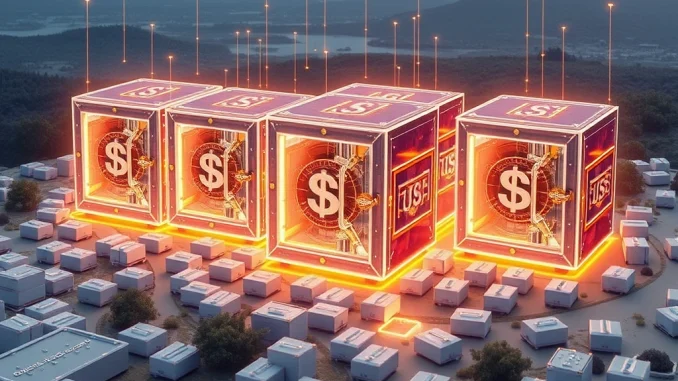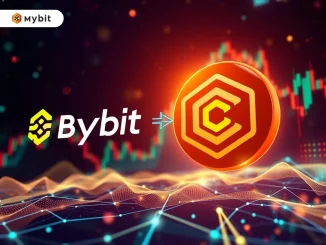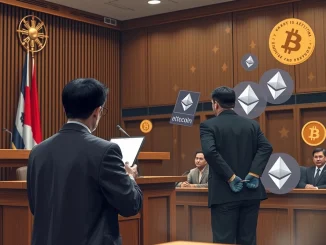
Have you been following the fascinating world of digital assets and how they’re bridging the gap with traditional finance? One area seeing remarkable growth is the tokenization of real-world assets (RWAs), particularly U.S. Treasurys. It’s a market that’s quickly gaining traction, but here’s a striking fact: a significant majority of these Tokenized Treasurys are held by just a handful of players.
Tokenized Treasurys: Understanding the Landscape
The tokenization of U.S. Treasurys involves issuing digital tokens on a blockchain that represent ownership or exposure to these traditional government bonds. Think of it as wrapping a familiar financial asset in new, programmable technology. This process aims to bring benefits like increased accessibility, fractional ownership, and 24/7 trading to an asset class historically limited by traditional market hours and structures.
Why the sudden interest? In the current economic climate, Treasurys offer relative stability and yield. By putting them on the blockchain, projects are making them available to a wider range of investors, including those within the crypto ecosystem looking for stable, yield-bearing options.
The Dominance: Six Funds Control 88% of Tokenized Treasurys
According to recent data from RWA.xyz, cited by Cointelegraph, the Tokenized Treasurys market, while growing, shows a high degree of concentration. A mere six funds currently account for a staggering 88% of the total assets under management (AUM) in this specific niche. This highlights that while the technology is decentralized, the initial adoption and control of these assets are quite centralized among a few major players.
This concentration isn’t necessarily unexpected in early-stage markets, especially when large financial institutions or well-funded crypto-native firms are involved. They have the capital, infrastructure, and regulatory expertise (or are building it) to launch and manage such products at scale.
Who Are the Key Players in Tokenized Real World Assets (RWAs)?
Let’s look at the funds leading this charge in the Real World Assets (RWAs) space, specifically focusing on Treasurys. These are the entities holding the lion’s share of the market:
- BlackRock’s BUIDL: Leading the pack with a significant market share.
- Franklin Templeton’s BENJI: Another traditional finance giant making waves in the digital asset space.
- Superstate’s USTB: A player focusing on bringing traditional securities to the blockchain.
- Ondo Finance’s USDY: Known for offering tokenized yield-bearing products.
- Circle’s USYC: A major stablecoin issuer expanding into tokenized assets.
- Ondo Finance’s OUSG: Another offering from Ondo focused on short-term Treasurys.
Here’s a snapshot of their approximate holdings based on the data:
| Fund | Issuer | Approximate AUM (Millions USD) |
|---|---|---|
| BUIDL | BlackRock | $2,500 |
| BENJI | Franklin Templeton | $707 |
| USTB | Superstate | $661 |
| USDY | Ondo Finance | $586 |
| USYC | Circle | $487 |
| OUSG | Ondo Finance | $424 |
(Note: AUM figures are approximate and based on the cited data at a specific point in time.)
Why is BlackRock BUIDL Leading the Pack?
It’s hard to ignore the scale of BlackRock BUIDL. As the world’s largest asset manager, BlackRock entering the tokenized asset space carries significant weight and instills confidence for many institutional investors and even retail participants comfortable with the BlackRock brand. Their fund, BUIDL, is designed to provide exposure to U.S. dollar yields via tokenized Treasurys and repurchase agreements. BlackRock’s extensive network and experience in traditional finance likely give them an edge in attracting large pools of capital quickly.
How Blockchain Technology Powers Tokenized Assets
At the heart of Blockchain Technology lies the ability to create immutable, transparent, and programmable records of ownership. For tokenized Treasurys, this means:
- Fractionalization: Allowing investors to own a piece of a high-value asset like a Treasury bond, which might otherwise be inaccessible.
- Increased Liquidity: Potentially enabling 24/7 trading on digital asset platforms, unlike traditional markets with limited hours.
- Transparency: Transactions and ownership can be verified on the public ledger (depending on the specific blockchain and implementation).
- Automation: Using smart contracts to handle interest payments or redemptions automatically.
Different funds utilize different blockchains, such as Ethereum or private/permissioned ledgers, based on their target audience and requirements for speed, cost, and privacy.
The Rise of Digital Assets in Traditional Finance
The prominence of Digital Assets like tokenized Treasurys signals a broader trend: the increasing convergence of traditional finance and blockchain technology. Major financial institutions are no longer just observing; they are actively participating, building infrastructure, and launching products. This move is driven by the potential for cost savings, increased efficiency, new revenue streams, and meeting evolving investor demand for digital-native investment options.
Tokenized Treasurys are often seen as a relatively low-risk entry point for institutions into the RWA space compared to more volatile assets. Their established legal framework and clear value make them ideal candidates for early tokenization efforts.
What Does This Concentration Mean for the Market?
While the dominance of six funds shows significant capital entering the Tokenized Treasurys space, it raises questions:
- Pros: Does it signal institutional confidence and pave the way for broader adoption? Does it create necessary liquidity and infrastructure in these early stages?
- Cons: Does it create centralization risks? Could it stifle competition or innovation from smaller players? Does it contradict the decentralized ethos often associated with blockchain?
For now, it seems the market is in a phase where scale and established names are critical for gaining traction. The challenge will be to see if this concentration persists or if the market diversifies as it matures.
Challenges and Opportunities in Tokenized RWAs
The path forward for tokenized Real World Assets (RWAs) isn’t without hurdles. Regulatory clarity remains a major challenge across jurisdictions. Ensuring legal enforceability of tokenized ownership and seamless interoperability between different blockchain networks and traditional systems are also key. Security of the underlying platforms and smart contracts is paramount.
However, the opportunities are immense. Beyond Treasurys, the RWA space could expand to include real estate, private equity, commodities, and more, unlocking liquidity and enabling new forms of investment and ownership globally. The efficiency gains offered by Blockchain Technology could revolutionize back-office operations in finance.
The Future Outlook for Tokenized RWAs
The current landscape, dominated by a few large funds in the Tokenized Treasurys sector, is likely just the beginning. As infrastructure improves, regulatory frameworks evolve, and more participants enter the space, we could see diversification. The involvement of major players like BlackRock and Franklin Templeton suggests that tokenized RWAs are not a fleeting trend but a significant development in the evolution of financial markets. Investors interested in this space should research the specific funds, understand the underlying assets, and be aware of the unique risks and opportunities presented by Digital Assets on the blockchain.
Conclusion
The tokenized U.S. Treasurys market is a rapidly developing segment within the broader Real World Assets (RWAs) narrative, showcasing how Blockchain Technology is starting to integrate with traditional finance. While dominated by a few key players like BlackRock BUIDL and others, this concentration underscores the significant institutional interest and capital flowing into the space. As this market matures, observing how it evolves, whether it diversifies, and how regulatory bodies respond will be crucial. The foundation is being laid for a future where Digital Assets representing tangible value become a more common part of the investment landscape.



